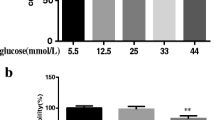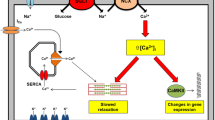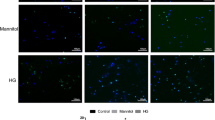Abstract
Diabetic cardiomyopathy is known to involve two forms of cardiac cell death: apoptosis and necrosis. However, it remains unknown whether hyperglycemia-induced apoptosis in the H9c2 cell culture system is inhibited by parasympathetic ganglionic neurons (PGN) derived exosomes (exos). We isolated PGN and sympathetic ganglionic neurons (SGN) from the right stellate ganglion in rats, and derived exos from these sources. H9c2 cells were divided into 4 groups: (1) Control, (2) H9c2 + Glucose (100 mmol/L), (3) H9c2 + Glucose + PGN-exos, and (4) H9c2 + Glucose + SGN-exos. We determined cell proliferation and viability with an MTT assay kit, and assessed apoptotic cell death with TUNEL staining and ELISA. Data were further confirmed by analyzing the presence of pro-apoptotic proteins Caspase-3 and Bax, and anti-apoptotic protein Bcl-2. Glucose exposed H9c2 cells significantly reduced cell viability, which was improved by PGN-exos, but not by SGN-exos. Furthermore, increased apoptosis in hyperglycemia in H9c2 cells was confirmed with TUNEL staining and cell death ELISA which demonstrated significantly (p < 0.05) reduction with PGN-exos treatment, but not with SGN-exos. Moreover, high expression of pro-apoptotic proteins Caspase-3 and Bax was reduced following treatment with PGN-exos; however, SGN-exos were unable to reduce the expression. Significantly reduced anti-apoptotic protein Bcl-2 following glucose treatment was improved with PGN-exos. Therefore, our data suggest that hyperglycemia induces apoptosis in H9c2 cells and decreases cell viability, and that PGN-exos are able to inhibit apoptosis, improve cell viability, and restore levels of anti-apoptotic protein Bcl-2.







Similar content being viewed by others
References
Rajchgot T, Thomas SC, Wang JC, Ahmadi M, Balood M, Crosson T, Dias JP, Couture R, Claing A, Talbot S (2019) Neurons and microglia; a sickly-sweet duo in diabetic pain neuropathy. Front Neurosci 13:25. https://doi.org/10.3389/fnins.2019.00025
Rehman K, Akash MSH (2017) Mechanism of generation of oxidative stress and pathophysiology of type 2 diabetes mellitus: how are they interlinked? J Cell Biochem 118:3577–3585. https://doi.org/10.1002/jcb.26097
Faria A, Persaud SJ (2017) Cardiac oxidative stress in diabetes: mechanisms and therapeutic potential. Pharmacol Ther 172:50–62. https://doi.org/10.1016/j.pharmthera.2016.11.013
Doll S, Dressen M, Geyer PE, Itzhak DN, Braun C, Doppler SA, Meier F, Deutsch MA, Lahm H, Lange R, Krane M, Mann M (2017) Region and cell-type resolved quantitative proteomic map of the human heart. Nat Commun 8:1469. https://doi.org/10.1038/s41467-017-01747-2
Gu H, Epstein PN, Li L, Wurster RD, Cheng ZJ (2008) Functional changes in baroreceptor afferent, central and efferent components of the baroreflex circuitry in type 1 diabetic mice (OVE26). Neuroscience 152:741–752. https://doi.org/10.1016/j.neuroscience.2007.11.030
Gu H, Zhang ZH, Epstein PN, Li L, Harden SW, Wurster RD, Cheng ZJ (2009) Impaired baroreflex control of renal sympathetic nerve activity in type 1 diabetic mice (Ove26). Neuroscience 161:78–85. https://doi.org/10.1016/j.neuroscience.2009.02.083
Lin M, Chen QH, Wurster RD, Hatcher JT, Liu YQ, Li L, Harden SW, Cheng ZJ (2010) Maternal diabetes increases small conductance Ca2+ -activated K+ (SK) currents that alter action potential properties and excitability of cardiac motoneurons in the nucleus ambiguus. J Neurophysiol 104:2125–2138. https://doi.org/10.1152/jn.00671.2009
Lin M, Hatcher JT, Chen QH, Wurster RD, Li L, Cheng ZJ (2011) Maternal diabetes increases large conductance Ca2+-activated K+ outward currents that alter action potential properties but do not contribute to attenuated excitability of parasympathetic cardiac motoneurons in the nucleus ambiguus of neonatal mice. Am J Physiol Regul Integr Comp Physiol 300:R1070–R1078. https://doi.org/10.1152/ajpregu.00470.2010
Parati G, Esler M (2012) The human sympathetic nervous system: its relevance in hypertension and heart failure. Eur Heart J 33:1058–1066. https://doi.org/10.1093/eurheartj/ehs041
Barile L, Milano G, Vassalli G (2017) Beneficial effects of exosomes secreted by cardiac-derived progenitor cells and other cell types in myocardial ischemia. Stem Cell Investig 4:93. https://doi.org/10.21037/sci.2017.11.06
Zhu L, Kalimuthu S, Gangadaran P, Oh JM, Lee HW, Baek SH, Jeong SY, Lee SW, Lee J, Ahn BC (2017) Exosomes derived from natural killer cells exert therapeutic effect in melanoma. Theranostics 7:2732–2745. https://doi.org/10.7150/thno.18752
Guay C, Kruit JK, Rome S, Menoud V, Mulder NL, Jurdzinski A, Mancarella F, Sebastiani G, Donda A, Gonzalez BJ, Jandus C, Bouzakri K, Pinget M, Boitard C, Romero P, Dotta F, Regazzi R (2019) Lymphocyte-derived exosomal microRNAs promote pancreatic beta cell death and may contribute to type 1 diabetes development. Cell Metab 29(348–361):e6. https://doi.org/10.1016/j.cmet.2018.09.011
Arslan F, Lai RC, Smeets MB, Akeroyd L, Choo A, Aguor EN, Timmers L, van Rijen HV, Doevendans PA, Pasterkamp G, Lim SK, de Kleijn DP (2013) Mesenchymal stem cell-derived exosomes increase ATP levels, decrease oxidative stress and activate PI3K/Akt pathway to enhance myocardial viability and prevent adverse remodeling after myocardial ischemia/reperfusion injury. Stem Cell Res 10:301–312. https://doi.org/10.1016/j.scr.2013.01.002
Jiang ZZ, Liu YM, Niu X, Yin JY, Hu B, Guo SC, Fan Y, Wang Y, Wang NS (2016) Exosomes secreted by human urine-derived stem cells could prevent kidney complications from type I diabetes in rats. Stem Cell Res Ther 7:24. https://doi.org/10.1186/s13287-016-0287-2
Khan M, Nickoloff E, Abramova T, Johnson J, Verma SK, Krishnamurthy P, Mackie AR, Vaughan E, Garikipati VN, Benedict C, Ramirez V, Lambers E, Ito A, Gao E, Misener S, Luongo T, Elrod J, Qin G, Houser SR, Koch WJ, Kishore R (2015) Embryonic stem cell-derived exosomes promote endogenous repair mechanisms and enhance cardiac function following myocardial infarction. Circ Res 117:52–64. https://doi.org/10.1161/CIRCRESAHA.117.305990
Katakowski M, Buller B, Zheng X, Lu Y, Rogers T, Osobamiro O, Shu W, Jiang F, Chopp M (2013) Exosomes from marrow stromal cells expressing miR-146b inhibit glioma growth. Cancer Lett 335:201–204. https://doi.org/10.1016/j.canlet.2013.02.019
Ono M, Kosaka N, Tominaga N, Yoshioka Y, Takeshita F, Takahashi RU, Yoshida M, Tsuda H, Tamura K, Ochiya T (2014) Exosomes from bone marrow mesenchymal stem cells contain a microRNA that promotes dormancy in metastatic breast cancer cells. Sci Signal 7:63. https://doi.org/10.1126/scisignal.2005231
Sahoo S, Losordo DW (2014) Exosomes and cardiac repair after myocardial infarction. Circ Res 114:333–344. https://doi.org/10.1161/CIRCRESAHA.114.300639
Lin M, Ai J, Harden SW, Huang C, Li L, Wurster RD, Cheng ZJ (2010) Impairment of baroreflex control of heart rate and structural changes of cardiac ganglia in conscious streptozotocin (STZ)-induced diabetic mice. Auton Neurosci 155:39–48. https://doi.org/10.1016/j.autneu.2010.01.004
Tavakoli Dargani Z, Singla R, Johnson T, Kukreja R, Singla DK (2018) Exosomes derived from embryonic stem cells inhibit doxorubicin and inflammation-induced pyroptosis in muscle cells. Can J Physiol Pharmacol 96:304–307. https://doi.org/10.1139/cjpp-2017-0340
Singla RD, Wang J, Singla DK (2017) Fibroblast growth factor-8 inhibits oxidative stress-induced apoptosis in H9c2 cells. Mol Cell Biochem 425:77–84. https://doi.org/10.1007/s11010-016-2863-2
Anversa P, Cheng W, Liu Y, Leri A, Redaelli G, Kajstura J (1998) Apoptosis and myocardial infarction. Basic Res Cardiol 93(Suppl 3):8–12
Liu R, Li X, Zhang X (2018) Dexmedetomidine protects high-glucose induced apoptosis in human retinal pigment epithelial cells through inhibition on p75(NTR). Biomed Pharmacother 106:466–471. https://doi.org/10.1016/j.biopha.2018.06.117
Chen M, Zheng H, Wei T, Wang D, Xia H, Zhao L, Ji J, Gao H (2016) High glucose-induced PC12 cell death by increasing glutamate production and decreasing methyl group metabolism. Biomed Res Int 2016:4125731. https://doi.org/10.1155/2016/4125731
Serrano-Oviedo L, Ortega-Muelas M, Garcia-Cano J, Valero ML, Cimas FJ, Pascual-Serra R, Fernandez-Aroca DM, Roche O, Ruiz-Hidalgo MJ, Belandia B, Gimenez-Bachs JM, Salinas AS, Sanchez-Prieto R (2018) Autophagic cell death associated to Sorafenib in renal cell carcinoma is mediated through Akt inhibition in an ERK1/2 independent fashion. PLoS ONE 13:e0200878. https://doi.org/10.1371/journal.pone.0200878
Singla DK, McDonald DE (2007) Factors released from embryonic stem cells inhibit apoptosis of H9c2 cells. Am J Physiol Heart Circ Physiol 293:H1590–H1595. https://doi.org/10.1152/ajpheart.00431.2007
Glass C, Singla DK (2011) MicroRNA-1 transfected embryonic stem cells enhance cardiac myocyte differentiation and inhibit apoptosis by modulating the PTEN/Akt pathway in the infarcted heart. Am J Physiol Heart Circ Physiol 301:H2038–H2049. https://doi.org/10.1152/ajpheart.00271.2011
Gessi S, Merighi S, Bencivenni S, Battistello E, Vincenzi F, Setti S, Cadossi M, Borea PA, Cadossi R, Varani K (2019) Pulsed electromagnetic field and relief of hypoxia-induced neuronal cell death: The signaling pathway. J Cell Physiol. https://doi.org/10.1002/jcp.28149
Fu C, Wang L, Tian G, Zhang C, Zhao Y, Xu H, Su M, Wang Y (2019) Enhanced anticancer effect of oncostatin M combined with salinomycin in CD133(+) HepG2 liver cancer cells. Oncol Lett 17:1798–1806. https://doi.org/10.3892/ol.2018.9796
Shen W, Zhao Y, Chen H, Zhang T, Wu S, Liu P (2019) M3, a natural lignan xyloside, exhibits potent anticancer activity in HCT116 cells. Oncol Lett 17:2117–2122. https://doi.org/10.3892/ol.2018.9823
Singla DK, Singla RD, McDonald DE (2008) Factors released from embryonic stem cells inhibit apoptosis in H9c2 cells through PI3K/Akt but not ERK pathway. Am J Physiol Heart Circ Physiol 295:H907–H913. https://doi.org/10.1152/ajpheart.00279.2008
Merino H, Singla DK (2018) Secreted frizzled-related protein-2 inhibits doxorubicin-induced apoptosis mediated through the Akt-mTOR pathway in soleus muscle. Oxid Med Cell Longev 2018:6043064. https://doi.org/10.1155/2018/6043064
Majtnerova P, Rousar T (2018) An overview of apoptosis assays detecting DNA fragmentation. Mol Biol Rep 45:1469–1478. https://doi.org/10.1007/s11033-018-4258-9
Crowley LC (2016) Marfell BJ and Waterhouse NJ (2016) Detection of DNA Fragmentation in Apoptotic Cells by TUNEL. Cold Spring Harb Protoc. https://doi.org/10.1101/pdb.prot087221
Cai L, Li W, Wang G, Guo L, Jiang Y, Kang YJ (2002) Hyperglycemia-induced apoptosis in mouse myocardium: mitochondrial cytochrome C-mediated Caspase-3 activation pathway. Diabetes 51:1938–1948
Chowdhry MF, Vohra HA, Galinanes M (2007) Diabetes increases apoptosis and necrosis in both ischemic and nonischemic human myocardium: role of caspases and poly-adenosine diphosphate-ribose polymerase. J Thorac Cardiovasc Surg 134:124–131. https://doi.org/10.1016/j.jtcvs.2006.12.059
Cai L, Wang Y, Zhou G, Chen T, Song Y, Li X, Kang YJ (2006) Attenuation by metallothionein of early cardiac cell death via suppression of mitochondrial oxidative stress results in a prevention of diabetic cardiomyopathy. J Am Coll Cardiol 48:1688–1697. https://doi.org/10.1016/j.jacc.2006.07.022
Fadini GP, Ferraro F, Quaini F, Asahara T, Madeddu P (2014) Concise review: diabetes, the bone marrow niche, and impaired vascular regeneration. Stem Cells Transl Med 3:949–957. https://doi.org/10.5966/sctm.2014-0052
Tattersall RB (1994) The quest for normoglycaemia: a historical perspective. Diabet Med 11:618–635
de Miguel V, Arias A, Paissan A, de Arenaza DP, Pietrani M, Jurado A, Jaen A, Fainstein Day P (2014) Catecholamine-induced myocarditis in pheochromocytoma. Circulation 129:1348–1349. https://doi.org/10.1161/CIRCULATIONAHA.113.002762
Hare JM, Keaney JF Jr, Balligand JL, Loscalzo J, Smith TW, Colucci WS (1995) Role of nitric oxide in parasympathetic modulation of beta-adrenergic myocardial contractility in normal dogs. J Clin Invest 95:360–366. https://doi.org/10.1172/JCI117664
Quan KJ, Van Hare GF, Biblo LA, Mackall JA, Carlson MD (2001) Endocardial stimulation of efferent parasympathetic nerves to the atrioventricular node in humans: optimal stimulation sites and the effects of digoxin. J Interv Card Electrophysiol 5:145–152
Li L, Huang C, Ai J, Yan B, Gu H, Ma Z, Li AY, Xinyan S, Harden SW, Hatcher JT, Wurster RD, Cheng ZJ (2010) Structural remodeling of vagal afferent innervation of aortic arch and nucleus ambiguus (NA) projections to cardiac ganglia in a transgenic mouse model of type 1 diabetes (OVE26). J Comput Neurol 518:2771–2793. https://doi.org/10.1002/cne.22363
Wang N, Chen C, Yang D, Liao Q, Luo H, Wang X, Zhou F, Yang X, Yang J, Zeng C, Wang WE (2017) Mesenchymal stem cells-derived extracellular vesicles, via miR-210, improve infarcted cardiac function by promotion of angiogenesis. Biochim Biophys Acta Mol Basis Dis 1863:2085–2092. https://doi.org/10.1016/j.bbadis.2017.02.023
He JG, Li HR, Han JX, Li BB, Yan D, Li HY, Wang P, Luo Y (2018) GATA-4-expressing mouse bone marrow mesenchymal stem cells improve cardiac function after myocardial infarction via secreted exosomes. Sci Rep 8:9047. https://doi.org/10.1038/s41598-018-27435-9
Xiao J, Pan Y, Li XH, Yang XY, Feng YL, Tan HH, Jiang L, Feng J, Yu XY (2016) Cardiac progenitor cell-derived exosomes prevent cardiomyocytes apoptosis through exosomal miR-21 by targeting PDCD4. Cell Death Dis. https://doi.org/10.1038/cddis.2016.181
Goldspink DF, Burniston JG, Ellison GM, Clark WA, Tan LB (2004) Catecholamine-induced apoptosis and necrosis in cardiac and skeletal myocytes of the rat in vivo: the same or separate death pathways? Exp Physiol 89:407–416. https://doi.org/10.1113/expphysiol.2004.027482
Pu J, Zhu S, Zhou D, Zhao L, Yin M, Wang Z, Hong J (2019) Propofol alleviates apoptosis induced by chronic high glucose exposure via regulation of HIF-1alpha in H9c2 cells. Oxid Med Cell Longev 2019:4824035. https://doi.org/10.1155/2019/4824035
Wang X, Pan J, Liu D, Zhang M, Li X, Tian J, Liu M, Jin T, An F (2019) Nicorandil alleviates apoptosis in diabetic cardiomyopathy through PI3K/Akt pathway. J Cell Mol Med. https://doi.org/10.1111/jcmm.14413
Trotta MC, Maisto R, Alessio N, Hermenean A, D’Amico M, Di Filippo C (2018) The melanocortin MC5R as a new target for treatment of high glucose-induced hypertrophy of the cardiac H9c2 cells. Front Physiol 9:1475. https://doi.org/10.3389/fphys.2018.01475
Yang YY, Sun XT, Li ZX, Chen WY, Wang X, Liang ML, Shi H, Yang ZS, Zeng WT (2018) Protective effect of angiotensin-(1–7) against hyperglycaemia-induced injury in H9c2 cardiomyoblast cells via the PI3KAkt signaling pathway. Int J Mol Med 41:1283–1292. https://doi.org/10.3892/ijmm.2017.3322
Chai W, Chen J, Wang H, Shen J, Ma L, Ma X (2000) The effects of glucose, insulin and oxidized low density lipoprotein on apoptosis in vascular endothelial cells. Chin Med J (Engl) 113:903–906
Tavakoli Dargani Z, Singla DK (2019) Embryonic stem cell-derived exosomes inhibit doxorubicin induced TLR4-NLRP3 mediated cell death—pyroptosis. Am J Physiol Heart Circ Physiol. https://doi.org/10.1152/ajpheart.00056.2019
Zhang Y, Hu YW, Zheng L, Wang Q (2017) Characteristics and roles of exosomes in cardiovascular disease. DNA Cell Biol 36:202–211. https://doi.org/10.1089/dna.2016.3496
Watanabe K, Jose PJ, Rankin SM (2002) Eotaxin-2 generation is differentially regulated by lipopolysaccharide and IL-4 in monocytes and macrophages. J Immunol 168:1911–1918. https://doi.org/10.4049/jimmunol.168.4.1911
Kondo M, Murakawa Y, Harashima N, Kobayashi S, Yamaguchi S, Harada M (2009) Roles of proinflammatory cytokines and the Fas/Fas ligand interaction in the pathogenesis of inflammatory myopathies. Immunology 128:e589–e599. https://doi.org/10.1111/j.1365-2567.2008.03039.x
Chen JJ, Sun Y, Nabel GJ (1998) Regulation of the proinflammatory effects of Fas ligand (CD95L). Science 282:1714–1717. https://doi.org/10.1126/science.282.5394.1714
Behzadi P, Behzadi E, Ranjbar R (2016) IL-12 family cytokines: general characteristics, pathogenic microorganisms, receptors, and signalling pathways. Acta Microbiol Immunol Hung 63:1–25. https://doi.org/10.1556/030.63.2016.1.1
Xu H, Li J, Zhao Y, Liu D (2017) TNFalpha-induced downregulation of microRNA-186 contributes to apoptosis in rat primary cardiomyocytes. Immunobiology 222:778–784. https://doi.org/10.1016/j.imbio.2017.02.005
Jarrah AA, Schwarskopf M, Wang ER, LaRocca T, Dhume A, Zhang S, Hadri L, Hajjar RJ, Schecter AD, Tarzami ST (2018) SDF-1 induces TNF-mediated apoptosis in cardiac myocytes. Apoptosis 23:79–91. https://doi.org/10.1007/s10495-017-1438-3
Rehman K, Akash MSH, Liaqat A, Kamal S, Qadir MI, Rasul A (2017) Role of interleukin-6 in development of insulin resistance and type 2 diabetes mellitus. Crit Rev Eukaryot Gene Expr 27:229–236. https://doi.org/10.1615/CritRevEukaryotGeneExpr.2017019712
Acknowledgements
This publication was derived from studies performed in partial fulfillment of Honors in the major thesis requirements for Mr. Reetish Singla at the University of Central Florida. The authors are thankful to Zahra Tavakoli Dargani for her technical assistance.
Funding
Internal resources were used to fund this project.
Author information
Authors and Affiliations
Corresponding author
Ethics declarations
Conflict of interest
There are no conflicts of interest to report.
Additional information
Publisher's Note
Springer Nature remains neutral with regard to jurisdictional claims in published maps and institutional affiliations.
Rights and permissions
About this article
Cite this article
Singla, R., Garner, K.H., Samsam, M. et al. Exosomes derived from cardiac parasympathetic ganglionic neurons inhibit apoptosis in hyperglycemic cardiomyoblasts. Mol Cell Biochem 462, 1–10 (2019). https://doi.org/10.1007/s11010-019-03604-w
Received:
Accepted:
Published:
Issue Date:
DOI: https://doi.org/10.1007/s11010-019-03604-w




